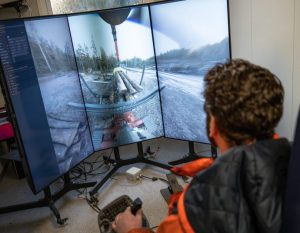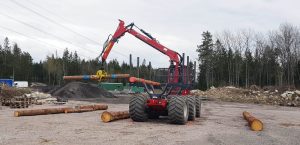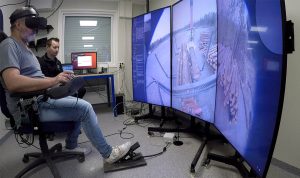Remote controlled forest machines are nothing new. The harvester system “The Beast and the Courier”, invented by Christer Lennartsson who we wrote about a while ago, was shown at the Elmia show in 2005. Then, it had already been underway for a couple of years. That concept never broke through. Is now the time for that … ?
Remote controlled forest machines – here we go again
For a couple of years now, the Swedish Forestry Research Institute, Skogforsk, is working on a remote-controlled forwarder. The purpose of the project is to create a more comfortable and safe working environment for the machine operators. With a less physically demanding working environment, Skogforsk hopes to gain higher productivity in logging operations.
Photo: Sverker Johansson/Bitzer
Easier to recruit young people to the forest
Another expected effect is that an improvement in the working environment will make it easier to convince a new generation to work in the forest. Few of today’s youngsters want to sit alone in a machine in the forest. If the machines can be controlled from long distances, an officelike environment can be created where the operators can actually sit next to each other, able to talk and have coffee breaks together. This could help in recruiting new fresh blood to the forest.
However, long-distance control is not yet available for this system. More on that below.
Optimization
In combination with the above mentioned working environment and the best digital mapping systems, route planning could be optimized. This could lead to less ground damage and fuel consumption. It should therefore also gain sustainable and environmentally friendly forestry.
Swedish state forest, Sveaskog, is testing
In a press release from the 13th August Sveaskog informed that they will test a remote controlled forwarder.
“With remote control the operator avoids vibrations”, says Linnèa Carlsson, technical specialist at Sveaskog and continues. “Also, for scarifying we would like to test remote controlled machines. Here the operators are exposed for extreme vibrations that could be decreased or avoided with the new technology by the fact that no one would have to sit in the machine.”
Photo: Skogforsk/Sveaskog
“For the moment we are looking at forwarders for this technology,” says Linnèa. “As for harvesters, solutions to optimize the cooperation between machine and operator with some kind of operator support is more interesting. When we have reached the full potential of the harvesters, we can start talking about remote controlled machines also there.”
Distance controlling
As mentioned above, the system that is running on trial today is not possible to control from a distance. The operator has to be within sight of the machine, or maybe in a personnel cabin, close enough to be able to stop the machine if an emergency occurs.
Methods to actually control machines from long distances are however being tested. It is possible through mobile communication. Either the public network or a local net just for this purpose.
Photo: Skogforsk
Challenges
It would be strange if such a thing would work without problems, just like that. The technology seems to work (with reservation for that I haven´t seen this machine myself). But someone has to fill up the fuel tank, lubricate grapple and crane, make the daily check for cracks, etc., put on chains and tracks and so on.
Also, when you are not in the machine you don´t feel what is happening. I see a risk that the speed will increase with a bigger risk of damaging the machine as a result. The risk of overturning also comes to mind, as the risk of driving in too steep slopes.
Linnea Westerberg is a machine operator at Sveaskog. She tested the remote controlled forwarder by sitting in a personnel cabin wearing VR-glasses.
“It´s quite different driving a forwarder like this,” she says. “The biggest difference is that you don´t feel the movements in the machine when it´s moving in the terrain.”
The test rig is equipped with a function that makes the levers vibrate, but according to Linnea that didn´t make anything better. However, Linnea believes that this is something that will come in the future.
“I wouldn´t be surprised if I will operate one of those in some years’ time,” she says.
Conclusion
The development has to go forward, no doubt, and this will most likely be a part of the future. I mean, why not? We already have self-driven trucks on some roads and on industry yards, there have been machines rolling around “by themselves” for a long time. So, I believe in this. If it´s not going to be exactly this machine, others will follow.
But it makes me just a little bit sad that the forest industry thinks that it will be easier to recruit young people by offering them “office” jobs. Forest workers, loggers, belong to the forest and should love to be in the forest. Why not pay them decently instead to get them?
Yes, I am a grumpy old man, I admit. But I do believe that in not too many years’ time we will see self-going forwarders on the clear cuts, surrounded by a lot of security details. I still wonder though, who will fill up the diesel tank?
We will follow the development of this.
Sources: Skogforsk, Sveaskog














